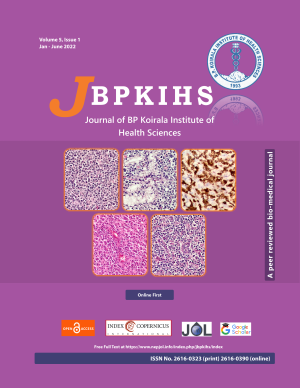Microbial Flora and Their Antibiotic Susceptibility in Oral and Maxillofacial Infections at BPKIHS: A Prospective Observational Study
DOI:
https://doi.org/10.3126/jbpkihs.v5i1.43381Keywords:
Antibiotic susceptibility, Enterococcus, Infection, Oral and maxillofacialAbstract
Background: We aimed to find out the causative bacteria involved in oral and maxillofacial infections, and to evaluate the antibiotic susceptibility by pus culture and sensitivity test.
Methods: This prospective observational study conducted over a one- year period enrolled all 41 consecutive patients with features of oral and maxillofacial infections visiting the oral and maxillofacial surgery clinic at the university hospital of B. P. Koirala Institute of Health Sciences. Pus was collected on a sterile syringe and sent to the microbiology laboratory. Pus samples were inoculated in 5% sheep blood agar and MacConkey agar and incubated at 37°C for 48 hours. Identification of the bacterial colony was done by gram staining and different biochemical tests. Antibiotic susceptibility tests were done by disc diffusion method on Mueller-Hinton agar as per CLSI guidelines.
Results: Out of 41 patients, 22 were male and 19 were female patients. The average age of the patients was 41.63 years. Odontogenic infection (17, 41.46%) was found to be the most common. Submandibular space (15, 36.59%) was the most common fascial space involved. The most common organism cultured was Enterococcus faecalis (13, 31.71%). The antibiotic susceptibility pattern of the isolates showed that 50% of the cultured organisms (n = 8) were resistant to Penicillin; five of them were Enterococcus faecalis and three were Staphylococcus aureus.
Conclusion: We found that Enterococcus faecalis as the common organism causing oral and maxillofacial infections with high resistance to Penicillin.
Downloads
Downloads
Published
How to Cite
Issue
Section
License
Copyright (c) 2022 Journal of BP Koirala Institute of Health Sciences

This work is licensed under a Creative Commons Attribution-NonCommercial-NoDerivatives 4.0 International License.
This license enables reusers to copy and distribute the material in any medium or format in unadapted form only, for noncommercial purposes only, and only so long as attribution is given to the creator.




